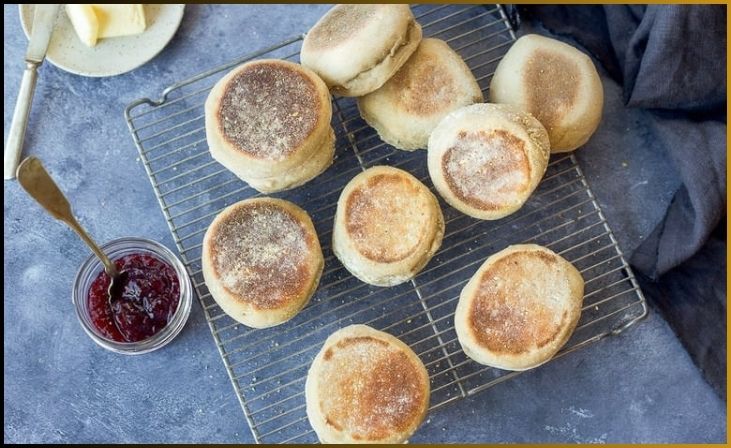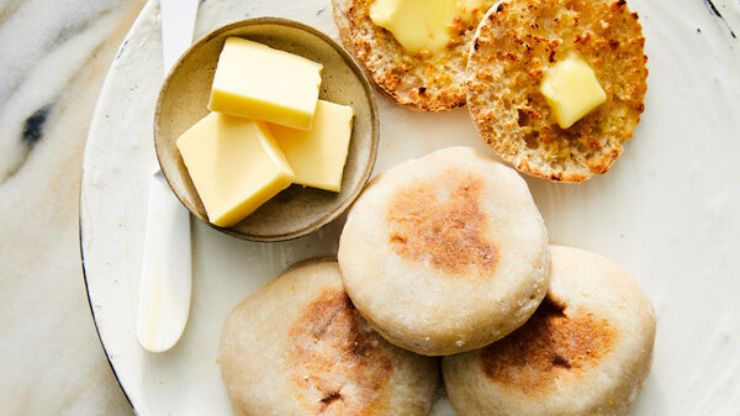Sourdough English Muffins – Welcome to the wonderful world of homemade sourdough English muffins! As the allure of sourdough baking continues to captivate culinary enthusiasts, these muffins stand out as a delightful and versatile creation. Crafting your own batch of sourdough English muffins is a satisfying culinary endeavor, offering a perfect balance of soft, nooks and crannies-rich interiors and a crisp, golden-brown exterior.
In this blog post, we’ll guide you through the process of creating these iconic breakfast treats, infused with the unmistakable tang of sourdough. You’ll not only learn the step-by-step method but also discover the joy of maintaining your sourdough starter.
So, dust off your apron, gather your ingredients and equipment, and get ready to embark on a mouthwatering journey of homemade sourdough English muffins. Whether you enjoy them toasted with butter and jam or as a base for eggs Benedict, your taste buds are in for a treat!
Table of Contents
ToggleIngredients
- 1 cup sourdough starter (fed and active)
- 1 1/2 cups all-purpose flour
- 1/2 cup milk
- 1 tablespoon sugar
- 1/2 teaspoon salt
- 1/2 teaspoon baking soda
- Cornmeal or semolina flour for dusting
Equipment
- Mixing bowl
- Griddle or skillet
- English muffin rings (or clean, empty tuna cans with the tops and bottoms removed)
- Rolling pin
- Dough cutter or cookie cutter
- Spatula
- Cooling rack
Also, Read – Pineapple Turmeric Sauerkraut Recipe
Sourdough English Muffins Recipe

Prepare the Sourdough Starter
To prepare a sourdough starter, mix equal parts flour and water (e.g., 1/2 cup of each) in a jar. Stir, cover with a cloth secured by a rubber band, and let it sit at room temperature.
Discard and replace half of the mixture with equal parts flour and water daily for about 5-7 days, or until it becomes bubbly and has a tangy aroma. Your starter is ready when it consistently doubles in size within 4-8 hours after a feeding.
Mix the Dough
To mix the sourdough English muffin dough, combine 1 cup of active sourdough starter, 1 1/2 cups all-purpose flour, 1/2 cup milk, 1 tablespoon sugar, and 1/2 teaspoon salt in a mixing bowl.
Stir until the ingredients form a shaggy dough. Turn it out onto a floured surface and knead for 5-10 minutes until smooth and elastic. This forms the base for your English muffins.
Knead the Dough
To knead the sourdough English muffin dough, place it on a floured surface. With floured hands, fold the dough in half, then push it away with the heels of your hands. Turn the dough 90 degrees and repeat the process.
Continue this folding and pushing motion for 5-10 minutes until the dough becomes smooth and elastic. If it becomes too sticky, sprinkle a bit more flour as needed. This kneading process helps develop gluten and structure in the dough.
Also, Read – Apple Spice Sauerkraut Recipe
First Rise
For the first rise of your sourdough English muffin dough, place it back in the mixing bowl, cover it with a clean kitchen towel or plastic wrap, and let it rest at room temperature for 4-8 hours or overnight.
Don't just scroll, subscribe!
BuzzTrail's unique web-stories are the cure for boredom you've been waiting for.
During this time, the dough will ferment and double in size. This extended rise allows the sourdough starter to impart flavor to the dough while developing a light, airy texture. It’s ready when it has visibly expanded and is puffy.
Second Rise
After the first rise, gently deflate the dough and divide it into 8-12 equal portions. Shape each piece into a ball and place them on a baking sheet dusted with cornmeal or semolina flour. Cover with a towel and let them rise for 1-2 hours, or until they’ve puffed up.
This second rise allows the individual muffins to develop more flavor and gives them the characteristic height and texture. They should visibly expand during this time and be ready for cooking.
Cook the English Muffins
To cook the sourdough English muffins, preheat a griddle or skillet over medium-low heat. Lightly grease the surface and the inside of English muffin rings (or tuna cans with tops and bottoms removed).
Dust the rings with cornmeal or semolina flour. Place them on the griddle and carefully set a muffin dough round into each ring.
Cook for about 5-7 minutes on each side until they’re golden brown and cooked through. Remove the rings, let the muffins cool on a wire rack, and split them with a fork before toasting and serving.
Cool and Split
After cooking, remove the sourdough English muffins from the griddle and allow them to cool on a wire rack. The cooling process helps set their texture.
Once they’ve cooled to a comfortable temperature, split the muffins in half using a fork to reveal the signature nooks and crannies.
This splitting method ensures the muffins absorb butter or other toppings well when toasted. Then, toast the split muffins to your desired level of crispiness before enjoying them.
To Serve
To serve your homemade sourdough English muffins, toast the split halves to your preferred level of crispiness. Then, spread them with butter, jam, or other toppings like cream cheese, honey, or eggs and bacon. The nooks and crannies of the muffins are perfect for trapping delicious flavors. Enjoy these warm, flavorful muffins as a delightful breakfast or snack.
Conclusion
In conclusion, baking your own sourdough English muffins is a rewarding experience that brings the timeless charm of these breakfast delights to your home kitchen. The distinct sourdough flavor, combined with the delightfully airy crumb and crisp crust, will leave your taste buds yearning for more.
As you experiment with various toppings and savor every bite, you’ll truly appreciate the art of sourdough baking. We hope you’ve enjoyed this journey, and we encourage you to share your muffin-making adventures with others. Happy baking, and may your mornings be forever enriched with the delicious aroma of freshly toasted sourdough English muffins!
FAQs
What’s the difference between sourdough English muffins and regular English muffins?
What’s the difference between sourdough English muffins and regular English muffins?
Sourdough English muffins are made with a sourdough starter, giving them a distinct tangy flavor, while regular English muffins are typically leavened with yeast.
Can I use a store-bought sourdough starter for this recipe?
Can I use a store-bought sourdough starter for this recipe?
Yes, you can use a store-bought sourdough starter, but creating your own sourdough starter can be a rewarding experience. If using a store-bought starter, ensure it’s active and well-fed.
How long does the sourdough starter need to be fed before using it in the recipe?
How long does the sourdough starter need to be fed before using it in the recipe?
It’s recommended to feed your sourdough starter and make sure it’s at its peak of activity, which usually takes about 4-6 hours after feeding.

